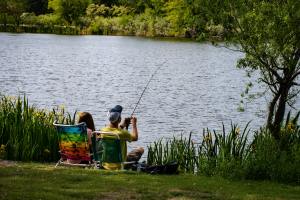
During the spring, there are several tasks that need to take place on farm ponds, according to Scott Jones, small impoundment specialist in the department of aquaculture and fisheries at the University of Arkansas at Pine Bluff.
“With warmer temperatures, aquatic weeds begin growing,” he said, “so now is the time for herbicide applications for highest efficacy.”
Publications MP556, Aquatic Vegetation Control in Arkansas (found at https://www.uaex.uada.edu/publications/pdf/MP556.pdf), SRAC0360, Aquatic Weed Management: Control Methods(found at https://srac.tamu.edu/fact-sheets/serve/65), and MP44, Arkansas 2023 Recommended Chemicals for Weed and Brush Control (found at https://www.uaex.uada.edu/publications/pdf/mp44/mp44.pdf), contain information on selecting herbicides. MP556 and MP360, Farm Pond Management for Recreational Fishing (found at https://www.uaex.uada.edu/publications/pdf/MP360.pdf) contain photos of many of the common problematic weeds in Arkansas.
The easiest plant identification tool available is Texas A&M’s AquaPlant “Identify a Plant” directory found at https://aquaplant.tamu.edu, Jones said. You can also send Jones photos of plants for advice by email at joness@uapb.edu.
It is important that if you encounter an aquatic weed you suspect to be non-native, such as hydrilla, giant salvinia or water hyacinth, (same for non-native fish like any of the bighead carps or snakehead) that you report it to Jones or the Arkansas Game and Fish Commission aquatic nuisance species program coordinator, Matt Horton, at Matthew.Horton@agfc.ar.gov or 877-470-3309 ext. 1206.
“You are a valuable resource in the field that can help fight the spread of harmful invasives,” he said. “If we confirm an invasive species on a land-owner’s property, we can work together to develop a plan to contain and hopefully eliminate that invasive from their property without disrupting normal operation.”
Fertilization and feeding programs should also be underway, Jones said. It is time for aquatic dye for weed/algae control.
“Be aware that during the rainy season dyes will need to be reapplied regularly to maintain effective concentration,” he said. “Continue herbicide applications for troublesome weeds.”
Spring is also a favorable time for fish stocking, Jones said. Species and numbers depend on the client’s situation and pond conditions. MP360 contains basic stocking species and rates. For advice on what, when and how many to stock, contact Jones or local AGFC fisheries biologists.
Harvest of largemouth bass (10-15 pounds per acre per year for normal ponds, 25-35 pounds/acre/year for bass-crowded or highly productive ponds) is encouraged, he said. Harvest bluegill less than about 7 inches in length up to about 25 pounds per acre per year. Releasing the larger bluegills maintains a healthy stock of breeding fish that are also great fun to catch.
“Aggressive harvest of all crappie caught, especially from ponds smaller than about 25 acres, is encouraged,” Jones said. “Crappie are sexually mature at about 6 inches and can spawn prolifically, often resulting in overpopulation in small ponds. So aggressive harvest of eating-size crappie often does not result in crippling the spawning capabilities of the fishery.”
Continue mowing grass on dams and levees to keep brush and saplings from developing, he said. Keep drains and spillways clear of debris and clogs so that they are working efficiently during the rainy season.
“Also continue the daily operation of aerators,” Jones said. “For diffused aeration systems that have not yet been activated, follow a simple startup schedule. Day one, run 30 minutes then turn it off the rest of the day. Day two, run one hour. Day three, run two hours. Day four, run four hours. Continue doubling the run time each day until you are running 24 hours per day and keep it on for the rest of the summer.”
The University of Arkansas at Pine Bluff offers all its Extension and Research programs and services without regard to race, color, sex, gender identity, sexual orientation, national origin, religion, age, disability, marital or veteran status, genetic information, or any other legally protected status, and is an Affirmative Action/Equal Opportunity Employer.

